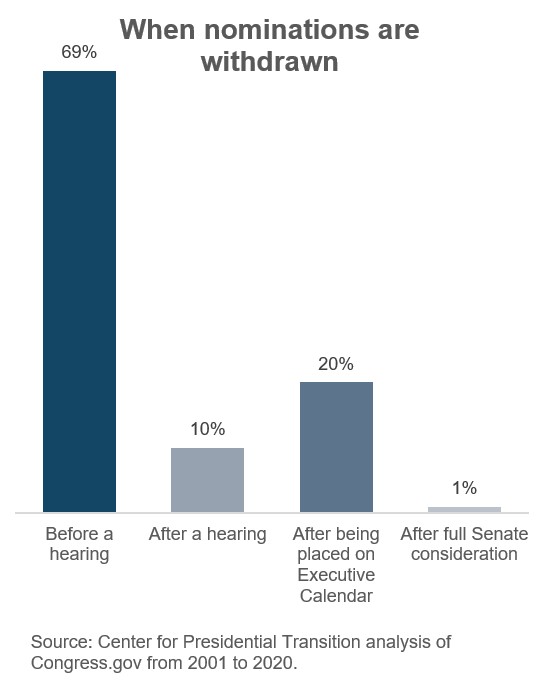Blog
March 18, 2021
Most nominations withdrawn from consideration by the senate happen prior to receiving a committee hearing
By Jaqlyn Alderete and Christina Condreay
Nominees seeking confirmation by the Senate to fill a presidentially-appointed position face a long and complex process. Each must contend with detailed vetting, background investigations, public scrutiny and challenging questions from the Senate. While the overwhelming majority of nominations are successful, withdrawals have occurred for every recent administration.
Of the more than 9,500 nominations Presidents George W. Bush, Barack Obama and Donald Trump submitted, 77% were eventually confirmed. Another 19% were “returned” by the Senate, meaning they never received a vote before a Senate recess or by the end of the calendar year. Some of those returned nominations were resubmitted and confirmed at a later date. Finally, 4% were withdrawn by the president. For the last three presidents, that totaled 335 nominations for an average of about 17 a year.
While these withdrawals make up a small percentage of presidential nominations, they often receive significant media attention and consume time and resources for the White House, which must find another candidate, and the Senate, which must take up more of its limited time to consider someone new. More than two-thirds of those withdrawn happen soon after they are submitted to the Senate and prior to receiving a committee hearing.
When are nominations withdrawn?

In recent years, a handful of nominations have been announced, but never sent to the Senate.For example, Bush announced Linda Chavez as his nominee for secretary of Labor and Obama announced Judd Gregg for secretary of Commerce, but neither individual was officially submitted for consideration. However, instances like these are uncommon.
An analysis by the Center for Presidential Transition® of the 335 withdrawn nominations submitted by Bush, Obama and Trump found most are abandoned early in the Senate confirmation process.
The analysis found that of the withdrawn nominations:
- 69% were dropped before any Senate committee held a hearing.
- 10% were vacated after a committee hearing, but before being placed on the executive calendar for full Senate consideration.
- 20% were placed on the executive calendar, but withdrawn before being considered by the full Senate.
- Only three of these nominations made it to the Senate floor for formal consideration, but were withdrawn before receiving a vote after motions to invoke cloture failed.
- None of the 335 nominations received a full Senate vote.
Why are nominations withdrawn?
To understand the reasons nominations were withdrawn, the Center analyzed a subset of 193 withdrawals for positions within 24 key agencies. Of those:

- 25% of the withdrawals involved issues in a nominee’s past. Both the administration and Senate committees vet nominees on aspects of their history such as their taxes, employment, conflicts of interest, public statements, social media accounts and publications. In addition, the committees consider a nominee’s position on key issues and evaluate how the individual will work with the Senate.
- 18% were withdrawn due to direct or indirect Senate opposition often due to an administration policy.
- 15% were withdrawn due to changes within an administration, such as an agency reorganization or a position title change, which are reasons unrelated to the specific nominee.
- 12% were withdrawn due to administrative errors. These situations include a nomination submitted with a specific position title when a general title was needed, or with an incorrect length of service indicated on the paperwork.
- 11% were withdrawn due to personal reasons. In some cases, the nominee cited delays and the length of the confirmations process as primary reasons. The Center identified 39 nominations that sat without any Senate action for more than a year before they were withdrawn. These delays can be caused by a senator placing a hold for reasons that may or may not be related to the nomination itself or the Senate majority leader’s decision not to bring a nomination up for a floor vote.
- 19% of the withdrawals studied had no public information on the causes available.
The president’s Cabinet usually gets confirmed with little opposition, but it is inevitable that nominees run into problems as a result of the Senate’s advice and consent role.



